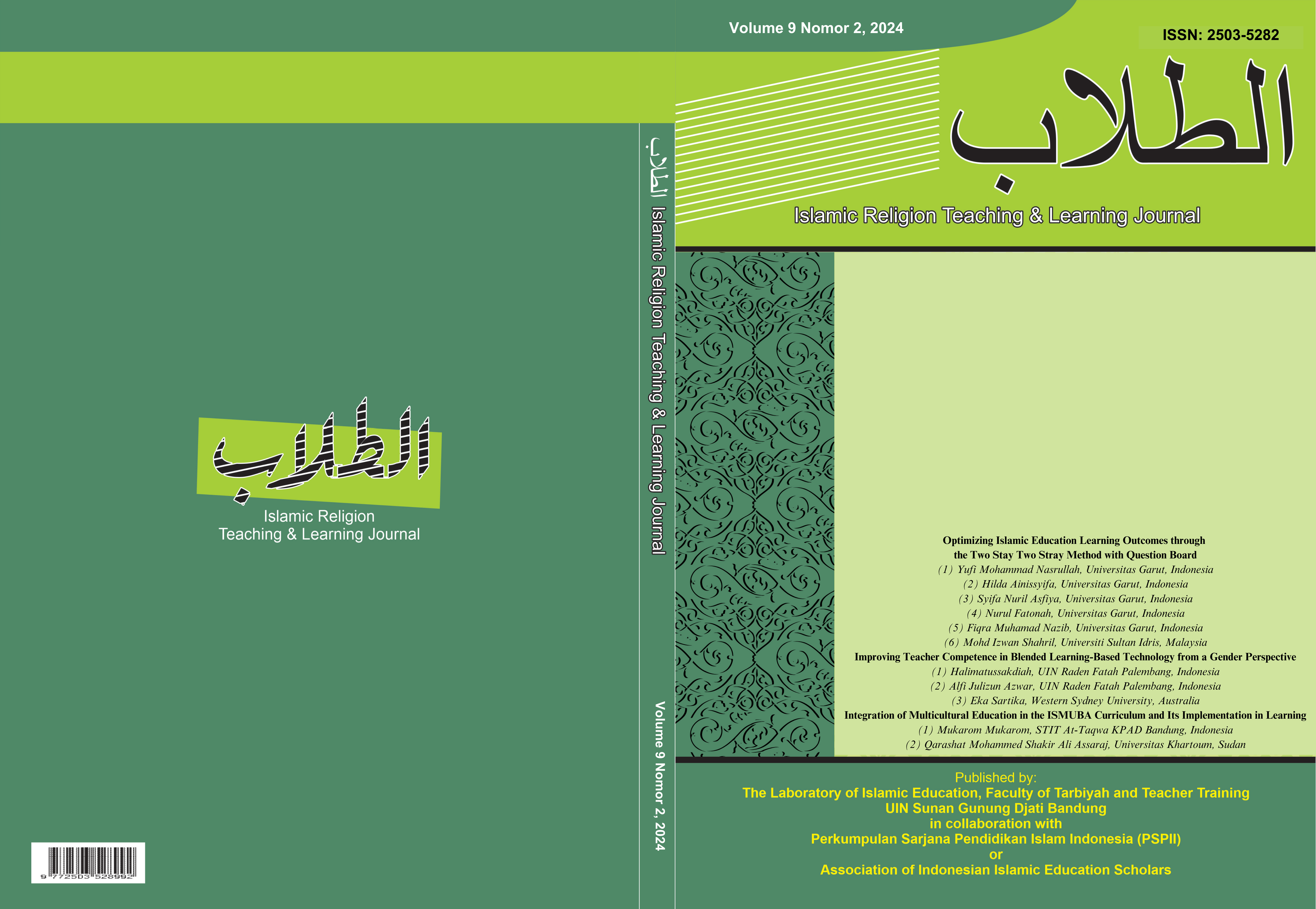Optimizing Islamic Education Learning Outcomes through the Two Stay Two Stray Method with Question Board
DOI:
https://doi.org/10.15575/ath.v9i2.37057Keywords:
Islamic Religious Education, Question Board, Two Stay Two Stray MethodsAbstract
This research aims to measure the effectiveness of this learning method in increasing students' understanding of the subject matter and gaining insight into students' perceptions of the learning experience. In this research, the TSTS methods are used as learning approaches that focus on active involvement, collaboration and critical thinking of students. Question board media is used to support the visualization of abstract concepts in Islamic Religious Education. Data was collected through comprehension tests, observation, pretest and posttest. The research results show that the TSTS learning methods using question boards have a positive impact on students' understanding. The test scores show that there is a significant effect before and after implementing this method. Where the result obtained is that tcount > ttable (4.30 > 2.06) so that H0 is rejected and Ha is accepted. So it can be concluded that there is a significant difference in the learning outcomes of Islamic Religious Education between the Pretest and Posttest for class XII social science 1 students at Asshiddiqiyah High School. Penelitian ini bertujuan untuk mengukur efektivitas metode pembelajaran ini dalam meningkatkan pemahaman siswa terhadap materi pelajaran dan memperoleh wawasan persepsi siswa terhadap pengalaman belajar. Dalam penelitian ini, metode TSTS digunakan sebagai pendekatan pembelajaran yang menitikberatkan pada keterlibatan aktif, kolaborasi dan berpikir kritis siswa. Media papan soal digunakan untuk menunjang visualisasi konsep-konsep abstrak dalam Pendidikan Agama Islam. Pengumpulan data dilakukan melalui tes pemahaman, observasi, pretest dan posttest. Hasil penelitian menunjukkan bahwa metode pembelajaran TSTS menggunakan papan soal memberikan dampak positif terhadap pemahaman siswa. Nilai tes menunjukkan terdapat pengaruh yang signifikan sebelum dan sesudah penerapan metode ini. Dimana hasil yang diperoleh adalah thitung > ttabel (4,30 > 2,06) sehingga H0 ditolak dan Ha diterima. Jadi dapat disimpulkan terdapat perbedaan yang signifikan hasil belajar Pendidikan Agama Islam antara Pretest dan Posttest siswa kelas XII IPS 1 di SMA Asshiddiqiyah.References
Abubakar, H. R. (2021). Pengantar Metodologi Penelitian. SUKA-Press UIN Sunan Kalijaga.
Aji, T. P., & Wulandari, S. S. (2021). Analisis Model Pembelajaran Kooperatif Tipe Two Stay Two Stray (TSTS) Terhadap Hasil Belajar Siswa. Journal of Office Administration : Education and Practice, 1(3), 340–350. https://doi.org/10.26740/joaep.v1n3.p340-350
Anggraeni, U. S. (2023). Pengaruh Penerapan Model Pembelajaran Two Stay Two Stray (TSTS) terhadap Hasil Belajar PAI Peserta Didik di Kelas V UPT SDN 16 Pinrang Kec. Watang Sawitto Kab. Pinrang. 02(01), 61–76.
Apriakanti, D., Kusuma, M., & Nurhayati, M. (2020). The Effectiveness of Two Stay Two Stray (TSTS) Cooperative Learning Model in Improving Students ’Critical Thinking Skills. Journal of Science Education Research, 4(1), 40–43. https://doi.org/10.21831/jser.v4i1.34240
Apriana, W. N., & Ridwan, A. F. (2023). Pengaruh Model Pembelajaran Kooperatıf Tıpe Two Stay Two Stray Terhadap Pemahaman Konsep Matematıs Sıswa Kelas V. KRAKATAU (Indonesian of Multidisciplinary Journals), 1(1), 15–26.
Apriliawati, D., Irawati, L., & Styati, E. W. (2017). The Effect Of Two Stay Two Stray (Tsts) Method On Recount Text Wrıtıng At The Eıghth Grade Students Of Smpn 2 Sawahan. 5(2), 50–57. https://doi.org/http://doi.org/10.25273/etj.v5i2.5445
Damopolii, I., & Iwan, I. (2018). Penerapan Model Pembelajaran Kooperatif Two Stay Two Stray (TSTS) Mata Kuliah Mikrobiologi untuk Meningkatkan Aktivitas Belajar Mahasiswa Melalui Kegiatan Lesson Study Di Jurusan Pendidikan Biologi FKIP UNIPA. Jurnal Eksakta Pendidikan (Jep), 2(2), 209. https://doi.org/10.24036/jep/vol2-iss2/229
Dwiputeri, D. F., Suyana, I., & Novia, H. (2023). Implementation of cooperative learning model with Two Stay Two Stray (TSTS) type to improve student’s communication skills. Prosiding Seminar Nasional Fisika (SiNaFi) 9.0, 2(1), 107–112.
Fatchurahman, M. A. S. M., Adella, H., & Setiawan, M. A. (2022). Development of Animation Learning Media Based on Local Wisdom to Improve Student Learning Outcomes in Elementary Schools. International Journal of Instruction, 15(1), 55–72.
Fitri, A. A., & Pertiwi, F. N. (2023). Efektivitas Model Pembelajaran Two Stay Two Stray (TSTS) Berbasis Teacher and Peer Feedback terhadap Kemampuan Refleksi Peserta Didik. Jurnal Tadris IPA Indonesia, 3(3), 238–251. https://doi.org/10.21154/jtii.v3i3.2166
Hamid, A. (2020). Penerapan Metode Keteladanan Sebagai Strategi Pembelajaran Meningkatkan Hasil Belajar Pendidikan Agama Islam. Al Fikrah:Jurnal Studi Ilmu Pendidikan Dan Keislaman, 3(2), 155.
Handriyani, E., & Abdillah, C. (2022). Implementasi Model Kooperatif Two Stay Two Stray (TSTS) Untuk Meningkatkan Kemampuan Kognitif IPA. Jurnal Pelita: Jurnal Pembelajaran IPA Terpadu, 2(2), 69–75. https://doi.org/10.54065/pelita.2.2.2022.203
Harisnur, F., & Suriana, S. (2022). Pendekatan, Strategi, Metode dan teknik Dalam Pembelajaran PAI di Sekolah Dasar. Genderang Asa: Journal of Primary Education, 3(1), 20–31. https://doi.org/10.47766/ga.v3i1.440
Ismawati, N., & Hindarto, N. (2021). Penerapan Model Pembelajaran Kooperatif Dengan Pendekatan Struktural Two Stay Two Stray Untuk Meningkatkan Hasil Belajar Siswa Kelas X Sma. Jurnal Pendidikan Fisika Indonesia, 7(1), 38–41.
Jailani, M., Widodo, H., & Fatimah, S. (2021). Pengembangan Materi Pembelajaran Pendidikan Agama Islam: Implikasinya Terhadap Pendidikan Islam. Al-Idarah: Jurnal Kependidikan Islam, 11(1), 145. https://doi.org/https://dx.doi.org/10.24042/alidarah.v11i1.8886
Juniantari, I. G. A. S., & Kusmariyatni, N. N. (2019). Pengaruh Model Pembelajaran Kooperatif Two Stay Two Stray Berbantuan Mind Mapping terhadap Hasil Belajar IPA. Jurnal Ilmiah Sekolah Dasar, 3(3), 378. https://doi.org/10.23887/jisd.v3i3.19478
Khudry, A. Al, Sri, M., Ari, L., Padang, U. N., Padang, K., Padang, U. N., & Padang, K. (2023). Peningkatan Hasil Belajar Peserta Didik Menggunakan Model Student Team Achievement Division ( STAD ) Pada Pembelajaran Tematik Terpadu diKelas V. Jurnal Elementaria Edukasia, 6(4), 2037–2050. https://doi.org/10.31949/jee.v6i4.7620
Kulsum, U., & Muhid, A. (2022). Pendidikan Karakter melalui Pendidikan Agama Islam di Era Revolusi Digital. Jurnal Intelektual: Jurnal Pendidikan Dan Studi Keislaman, 12(2), 157–170. https://doi.org/10.33367/ji.v12i2.2287
La Una, W. (2023). Implementation Of Two Stay Two Stray Cooperative Learning ( Tsts ) To Improve The Activity And Outcomes Of Science Learning By Class Viii Students Of Smp Negeri 12 Poleang Barat 2019 / 2020 Academic Year. Journal of Teaching and Education, 2(1), 59–71. https://doi.org/http://dx.doi.org/10.31327/jte.v2i1.1944
Lubis, M. A. (2018). Pengaruh Model Pembelajaran Kooperatif Tipe Two Stay Two Stray (Tsts) Dan Artikulasi Terhadap Hasil Belajar Siswa Pada Materi Ekosistem Di Sma Negeri 1 Sibabangun Kabupaten Tapanuli Tengah. Jurnal Biolokus, 1(2), 117. https://doi.org/10.30821/biolokus.v1i2.352
Lusiana, I. A., Setyosari, P., & Soetjipto, B. E. (2017). The Application of Two Stay Two Stray (TSTS) and Fan-N-Pick Learning Models to Improve Studentsâ Motivation and Learning Outcomes on Social studies Subject (A Study on the Fourth Grade students of SDN Tawun I Ngawi). International Journal of Academic Research in Progressive Education and Development, 6(3). https://doi.org/10.6007/ijarped/v6-i3/3138
Maskhuroh, L., & Bakar, H. A. (2019). Problematika Pembelajaran Pendidikan Agama Islam (Pai Qur-Any) Di Sma Primaganda Jombang. Ilmuna: Jurnal Studi Pendidikan Agama Islam, 1(1), 58–75.
Nafisah, D., & Sahlan, M. (2023). Spesifikasi Konsep Evaluasi pada Pengembangan Teknik Assesmen Kompetensi Sikap terhadap Pembelajaran PAI di SMP. MA’ALIM: Jurnal Pendidikan Islam, 4(2), 216–231. https://doi.org/10.21154/maalim.v4i2.6685
Nasution, B., & Zulkifli, N. (2023). Metode Pembelajaran dan Teknik Mengajar dalam Pendidikan Agama Islam (PAI) oleh Guru Pendidikan Agama Islam. Khazanah Pendidikan, 17(1), 142–153. https://doi.org/10.30595/jkp.v17i1.16027
Ningsih, S. R., Purwaningrum, J. P., & Sumaji. (2023). Pengaruh Model Pembelajaran Two Stay-Two Stray Berbantuan Media Mathcircle Terhadap Kemampuan Komunikasi Matematis Siswa. Jurnal Pendidikan Matematika, 14(2), 178–185. https://doi.org/https://doi.org/10.36709/jpm.v14i2.72
Permata, I., Vai, A., & Wedi, S. (2023). Penerapan Metode Pembelajaran Two Stay Two Stray (TSTS) untuk Meningkatkan Hasil Belajar Siswa pada Materi Budaya Hidup Sehat di Tingkat Sekolah Dasar Negeri 110 Pekanbaru. Journal on Education, 5(3), 6433–6439. https://doi.org/10.31004/joe.v5i3.1425
Prasetio, D. (2023). The Influence Of Learnıng Medıa Usabılıty And Learnıng Motıvatıon On Student Learnıng Outcomes In Economıcs International Journal Of Current Economics & Business Ventures. 1(1), 61–74.
Putri, C. A., Muhammadiyah, U., & Hamka, P. (2023). Pengaruh Model Pembelajaran RADEC berbasis STEAM terhadap Literasi Sains Siswa Kelas IV Sekolah Dasar. Jurnal Elementaria Edukasia, 6(3), 1162–1170. https://doi.org/10.31949/jee.v6i3.6280
Rachman, T. (2018). Teori Tentang Metode Two Stay Two Stray (Tsts) Dan Motivasi Belajar. Angewandte Chemie International Edition, 6(11), 951–952., 10–27.
Rafi, H., Suyoto, S., Sumarno, S., & Rumiarci, E. (2024). Peningkatan Hasil Belajar Siswa Melalui Model Problem Based Learning Pada PPKn SDN Sambirejo 02. Jurnal Edukasi: Kajian Ilmu Pendidikan, 9(2), 65–73. https://doi.org/10.51836/je.v9i2.644
Rahim, R., Syaifudin, S., & Nery, R. S. (2019). Model Pembelajaran Kooperatif Tipetwo Stay Two Stray (Tsts) Terhadap Hasil Belajar Siswa. Jurnal Penelitian Pendidikan Matematika, 1(1), 39. https://doi.org/10.32502/jp2m.v1i1.683
Rahmadania, S. (2021). Peran Pendidikan Agama Islam Dalam Keluarga Dan Masyarakat. Edumaspul, 5(2), 221–226.
Rahmawati, A. A., Isnaeni, W., & Retnowati, L. (2023). The Implementation of Problem Based Learning (PBL) with Two Stay Two Stray (TSTS) to Increase Motivation and Learning Outcomes on Environmental Change Material for SMA. Journal of Biology Education, 12(3), 403–410. https://doi.org/https://doi.org/10.15294/jbe.v12i3.74991
Rasdiana, R., Juddah, A. B., & Selle, H. (2019). Applying Two Stay Two Stray (Tsts) Technique by Using Picture Series to Improve Students’ Speaking Skill at the Secondgrade in Man 2 Parepare. Journal of Linguistics and English Teaching Studies, 2(2), 25–43. https://doi.org/https://doi.org/10.35905/inspiring.v2i2.1270
Rohmat, I. N., Setyawan, M. N. K., & Salsabila, I. A. (2023). Teknik Evaluasi Pembelajaran PAI. Ta’limDiniyah: Jurnal Pendidikan Agama Islam (Journal of Islamic Education Studies), 4(1), 157–177. https://doi.org/10.53515/tdjpai.v4i1.102
Safitri, A., Achmad, A., & Marpaung, R. R. T. (2015). Pengaruh Model Pembelajaran Two Stay Two Stray (TSTS) terhadap Hasil Belajar Siswa. Jurnal Bioterdidik: Wahana Ekspresi, 3(2), 55–58. https://jurnal.fkip.unila.ac.id/index.php/JBT/article/view/7465/0
Sari, A., & Azmi, M. P. (2018). Penerapan Model Kooperatif Tipe Two Stay Two Stray (Tsts) Terhadap Kemampuan Komunikasi Matematis. Jurnal Cendekia : Jurnal Pendidikan Matematika, 2(1), 164–171. https://doi.org/10.31004/cendekia.v2i1.42
Setiawati, G. A. D. (2023). Penerapan Model Pembelajaran Group Investigation Berbasis Lingkungan Sekitar pada Mata Pelajaran IPAS. Jurnal Elementaria Edukasia, 6(4), 1915–1925. https://doi.org/https://doi.org/10.31949/jee.v6i4.6619
Silalahi, M., & Sary, Y. W. (2020). The using of two stay two stray (tsts) strategy on students’ reading comprehension. Bilingual: Jurnal Pendidikan Bahasa Inggris, 2(2), 70–77. https://doi.org/10.36985/jbl.v2i2.134
Sujarwo, S., Japar, J., & Sumantri, S. (2024). The Effect of Virtual Reality Learning Media on Student Social Studies Learning Outcomes in Junior High Schools. KnE Social Sciences, 3, 263–269. https://doi.org/10.18502/kss.v9i2.14853
Supriadi, H. (2023). Penyusunan Teks Kloz sebagai Teknik Pembelajaran Terpadu : Supervisi Kepala Sekolah terhadap Guru Kelas Tinggi. Jurnal Pembelajaran Bahasa Dan Sastra, 2(1), 37–48. https://doi.org/https://doi.org/10.55909/jpbs.v2i1.216
Suryanti, S., Zawawi, I., & Fauziyah, S. (2017). Peningkatan Penguasaan Konsep Matriks Melalui Model Pembelajaran Kooperatif Tipe Two Stay Two Stray (TSTS) (Lesson Study Dengan Mengambil Obyek Mata Kuliah Matriks Di Semester 2). DIDAKTIKA : Jurnal Pemikiran Pendidikan, 21(1), 14–27.
Syafrin, Y., Kamal, M., Arifmiboy, A., & Husni, A. (2023). Pelaksanaan Pembelajaran Pendidikan Agama Islam. Educativo: Jurnal Pendidikan, 2(1), 72–77. https://doi.org/https://doi.org/10.56248/educativo.v2i1.111
Unique, A. (2022). Penerapan metode Two Stay Two Stray (TSTS) dengan Number Head Together (NHT) dalam meningkatkan aktivitas belajar siswa (Penelitian Quasi Experimen terhadap Siswa Kelas VII SMPN 56 Bandung pada Mata Pelajaran PAI). UIN Sunan Gunung Djati Bandung.
Wahyudi, I. (2024). The Effect Of Two Stay Two Stray Teaching Method On Reading Comprehension Of The Eight Grade Students’ Of SMPN 1 Wawotobi. Innovative: Journal Of Social Science Research, 4(1), 10395–10406. https://doi.org/https://doi.org/10.31004/innovative.v4i1.8805
Wahyuni, D. S., Aprison, W., Charles, C., & Junaidi, J. (2023). Problematika Siswa Muslim Dalam Mengikuti Pembelajaran PAI Di SD Keluarga Kudus Kecamatan Luhak Nan Duo Kabupaten Pasaman Barat. ALFIHRIS: Jurnal Inspirasi Pendidikan, 1(2), 88–107. https://doi.org/https://doi.org/10.59246/alfihris.v1i2.218
Widyastuti, N. N. S., Saputra, H. H., & Oktaviyanti, I. (2022). Pengaruh Model Pembelajaran Two Stay Two Stray Dipadu Picture And Picture Terhadap Hasil Belajar Ips Siswa Kelas IV SDN Gugus 06 Cakranegara Tahun Pelajaran 2020/2021. Jurnal Ilmiah Mandala Education, 8(1), 958–963. https://doi.org/10.58258/jime.v8i1.2926
Zahra, F., Habibah, U., & Nurela, N. (2024). Problematika pembelajaran pai dan upaya mengatasinya. Jurnal Pendidikan Educandum, 4(1), 38–52. https://doi.org/https://doi.org/10.55656/jpe.v4i1.175
Downloads
Published
How to Cite
Issue
Section
License
Authors who publish with this journal agree to the following terms:
- Authors retain copyright and grant the journal right of first publication with the work simultaneously licensed under a Creative Commons Attribution-ShareAlike License that allows others to share the work with an acknowledgement of the work's authorship and initial publication in this journal.
- Authors are able to enter into separate, additional contractual arrangements for the non-exclusive distribution of the journal's published version of the work (e.g., post it to an institutional repository or publish it in a book), with an acknowledgement of its initial publication in this journal.
- Authors are permitted and encouraged to post their work online (e.g., in institutional repositories or on their website) prior to and during the submission process, as it can lead to productive exchanges, as well as earlier and greater citation of published work (See The Effect of Open Access).




